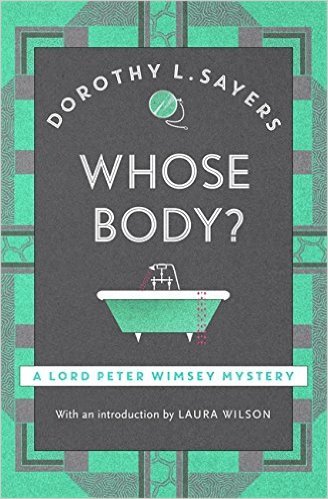I’m kicking off my #20booksofsummer24 challenge hosted by Cathy @746books with a classic of golden age detective fiction: Whose Body? by Dorothy L. Sayers. Whose Body? is the first title in her famous Lord Peter Wimsey series, which spanned 15 books, including several short story collections.
The Plot:
Thipps, an architect, discovers a dead body wearing only a pair of pince-nez in the bathtub of his London flat. Lord Peter Wimsey, a nobleman with a newfound interest in criminal investigation, decides to look into the matter privately. The official investigation is led by Inspector Sugg, who speculates that the body might be that of the famous financier Sir Reuben Levy, who vanished from his bedroom under mysterious circumstances the previous night. Inspector Charles Parker, a friend of Wimsey’s, handles Sir Reuben’s disappearance. Despite the superficial resemblance to Sir Reuben, it soon becomes clear that the body in the bath is not him, and the two cases seem unrelated. Wimsey joins Parker in the investigation.

The Review:
I recently finished reading Whose Body? by Dorothy L. Sayers, and I would give it a solid 3.5 stars. As the first book in the Lord Peter Wimsey series, it introduces us to the charming and aristocratic detective, Lord Peter Wimsey, who has developed a keen interest in solving crimes as a hobby.
The story kicks off with a peculiar case: Thipps, an architect, finds a dead body wearing nothing but a pair of pince-nez in the bathtub of his London flat. Intrigued by this bizarre discovery, Lord Peter decides to investigate. His investigation runs parallel to the official one led by Inspector Sugg, who is quick to assume that the body might be that of the famous financier Sir Reuben Levy, who disappeared mysteriously the night before. However, Wimsey’s friend, Inspector Charles Parker, is already on Sir Reuben’s case and is not convinced the body is his.
Sayers does a commendable job of weaving together the seemingly unrelated disappearance of Sir Reuben and the appearance of the unknown body. The plot thickens when it’s revealed that Thipps’s flat is near a teaching hospital, leading Wimsey to speculate whether the body could be part of a student prank. However, Sir Julian Freke, a prominent surgeon and neurologist, testifies that no bodies are missing from the hospital, ruling out this theory.
One of the novel’s strengths is Sayers’s ability to create vivid, memorable characters. Lord Peter Wimsey is particularly engaging, with his sharp wit and keen sense of justice. However, the plot does take some time to gather momentum, and there are moments when the narrative feels bogged down by detailed descriptions and procedural aspects.
Unlike many of Sayers’ later Lord Wimsey novels, Whose Body? is a pure mystery and doesn’t have the depth of her later books, where she weaves in themes of women’s rights, the plight of shell-shocked soldiers, religion, and commentary on the social status of British life.
In Whose Body? The only actual theme developed is Parker’s assertion that solving crimes is not entertainment or a puzzle to be played with and discarded by the landed gentry. Solving murders means coming in contact with heinous inhumanity, and to be a good investigator; one must recognize the terrible misdeed that has been done and be driven to snuff out such evil where it exists.

Parker’s pronouncement and obvious irritation at Wimsey’s “playing detective” are brushed off by Wimsey, whose detached and bemused air is in great contrast to how he is completely and utterly destroyed by sending a man to his death in his last book, Busman’s Honeymoon.
Wimsey’s detached laissez-faire attitude towards solving crime is contrasted with the detached laissez-faire attitude of the murderer, who killed and desecrated bodies to prove a scientific theory. It makes the reader wonder why the great scientific brainiac detective is revered. Does he value life more than the criminal working on the same principles?
I think Sayers has a lot to say about people who see murder as entertaining fodder and draws a main character in Wimsey who is emotionally detached from his new “hobby” who, throughout the series, finds solving crime to be a terrible and tremendous vocation one that eventually costs him a great deal.
Whose Body? has the seedlings of many great threads later developed to their full potential: Wimsey’s PTSD, his deep abiding friendship with Bunter, and his thumbing his nose at the social customs of the aristocracy, but they are not the focus of this mystery.
Overall, Whose Body? is an enjoyable read, especially for fans of classic detective fiction. While it may not be as fast-paced or gripping as some of Sayers’ later Peter Wimsey novels, it offers a delightful blend of humor, intellect, and a well-crafted puzzle; like Wimsey, it will take a few books for Sayers to hone her craft and create a genuinely resplendent mystery. Although I feel the resolution is a bit overwrought, I’m not sure it could be done at the speed necessary to pull off the murder. The lack of viable suspects and relatively easy-to-put-together clueing makes Sayers’s first mystery a fun little mystery but not a tour de force. She is more restrained in her beautiful discourses of place and time, and the mystery is utterly bereft of her well-placed puns, wordplay, and liberal use of French, Latin, and classical imagery, which color her later mysteries.
I look forward to seeing how Lord Peter Wimsey’s character develops in subsequent books from detached, interested logician toward tortured-winged nemesis and to watch Sayers grow into a more toothsome and rich writer.
Lord Peter Wimsey Reviews:
The Unsolved Puzzle of the Man With No Face

Dorothy L. Sayers Biography
Dorothy L. Sayers (1893-1957) was a renowned British writer, translator, and scholar, best known for her detective fiction featuring the character Lord Peter Wimsey. Sayers was a prominent figure in the early 20th-century literary scene, contributing significantly to the detective genre and broader literary scholarship.
Dorothy Leigh Sayers was born on June 13, 1893, in Oxford, England. She was the only child of Reverend Henry Sayers, a Church of England clergyman, and his wife Helen Mary Leigh. Sayers showed early academic promise and a keen interest in literature. She received her education at the Godolphin School in Salisbury and later attended Somerville College, Oxford, where she studied modern languages and medieval literature. In 1915, she graduated with first-class honors, among the first group of women to receive degrees from Oxford University.
After graduation, Sayers worked in various jobs, including as a teacher and a copywriter for an advertising agency. Her experiences in the advertising industry inspired her to create some of the more memorable scenes in her novels, showcasing her wit and observational skills.
Sayers is best known for her detective novels featuring Lord Peter Wimsey, a charismatic and aristocratic amateur sleuth. Her first Wimsey novel, Whose Body?, was published in 1923. The character of Lord Peter quickly gained popularity, and Sayers went on to write a series of successful novels and short stories featuring him. Some of her most acclaimed Wimsey novels include Strong Poison (1930), The Five Red Herrings (1931), Murder Must Advertise (1933), and Gaudy Night (1935).
Sayers’ detective fiction was celebrated not only for its intricate plots but also for its rich character development and exploration of social issues. Her work often delved into themes such as the role of women in society, ethical dilemmas, and the nature of justice.
Dorothy L. Sayers passed away on December 17, 1957, in Witham, Essex. Her legacy endures through her contributions to literature, particularly in the realm of detective fiction. Sayers’ work continues to be celebrated for its intelligence, wit, and depth, making her a significant figure in the literary world.
Sayers’ influence extends beyond her fiction; she was also a respected scholar and a founding member of the Detection Club, an elite group of mystery writers. Her work has inspired generations of writers and continues to be read and appreciated by audiences worldwide.

My first book of the 20 Books of Summer 24 challenge is done. You can find what other books are on my list here.





Leave a comment